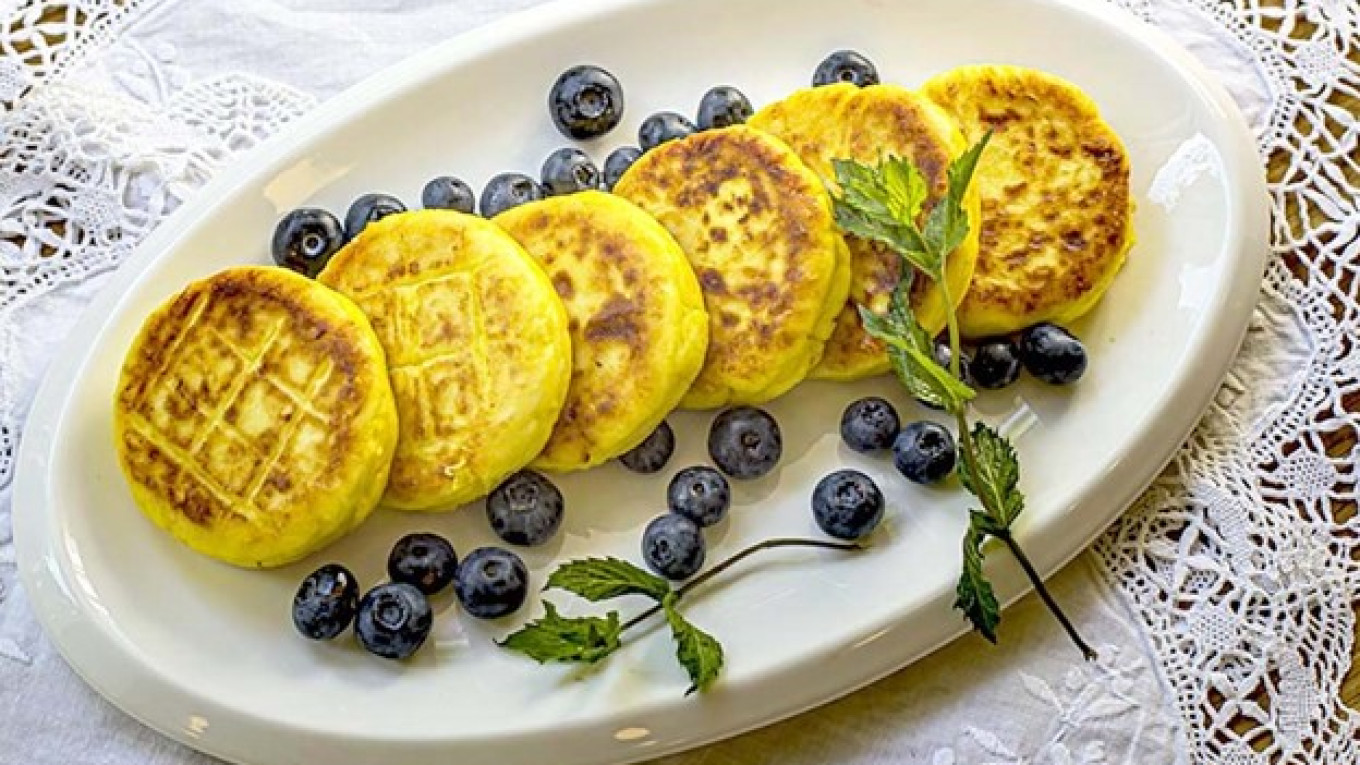Syrniki are thick curd cheese “pancakes” that everyone knows and loves. But where does the word "synik" come from? Most people think it comes from the Russian word for cheese (сыр). And they are partially right. Some linguists believe that in medieval Rus сыр was the word used for what is now called творог (cottage cheese, curd cheese, pot cheese or quark, depending on where you live). But it’s a bit more complicated.
On the one hand, centuries ago curd cheese was in fact sometimes referred to as "сиръ." But it must have referred to a different kind of cheese, too, since we find the word in the Novgorod birch bark letters from the 12th to 14th centuries. In the letters, cheese (сиръ) is purchased along with salted fish or used as an in-kind rent payment for land and taxes. Curd cheese, which is highly perishable, couldn’t be used in those situations.

Another version suggests that the word сыр in the sense of curd cheese was borrowed from Ukrainian, but etymological dictionaries say this is unlikely. First of all, as we have seen above, the word was used in the pre-Mongolian era when the Ukrainian and Russian languages in their present forms did not exist.
The most likely explanation is that the old word сиръ originated in the Proto-Slavonic language with the meaning of "sour milk," "whey" or "leavening.” From there, the word entered many Slavic languages, Old Prussian and even Old Dutch. The modern Russian word for curd cheese, творог, came into the Russian language much later. For example, the word isn’t found in the very detailed descriptions of products and recipes in "Domostroi," written in the middle of the 16th century.
But why is there just one word for both curd cheese and hard cheese in Russia? Simple. No one in Russia made any aged cheeses until the 17th century. The Russian “cheese” made before then was similar to today’s bryndza, feta, and so on — or even just pressed, salted curd cheese. That is, it did not need special ageing.
Syrniki begin to be mentioned only in the 16th century. But we don’t really know what they were like. The "Domostroi" (1550s) mentions “syrniki with eggs and cheese." In the “List of the Boyar Morozov's Feasts (1650s) we again find "syrniki with cheese.” But these dishes are sometimes included in lists of pies with fillings.
But why would syrniki be described as “made with cheese” — even if they are referring to curd cheese? Could they have been made from something else? As it turns out, yes. The old Russian syrnik is nothing like its modern descendent. Even Vladimir Dahl writes in his dictionary that syrniki are “pastries or thin blinis filled with curd cheese."
A book published in 1811 called "The Newest Complete and Perfect Russian Cook" wrote, "Take the desired number of prepared blinis, put curd cheese mixed with eggs in the center, fold down the edges, fold it in half and fry in butter.” That was a syrnik 200 years ago.

Of course, there were simpler versions of this dish. In one of the first editions of Yelena Molokhovets' cookbook (1866), you can find a recipe for "boiled syrniki”: “Take fresh curd cheese, knead it, add butter, eggs and flour, roll it on the table, cut it into pieces a quarter of an inch (4.4 cm) thick, and boil them in boiling salted water. Serve with melted butter and sprinkled with crushed breadcrumbs.”
Only in the second half of the 19th century do we find a recipe for fried syniki which is close to the modern recipe — the recipe that became virtually the only one in the Soviet era. But this did not happen right away. In the late 1950s the classic “Book of Tasty and Healthy Food” used the word tvorozhnik (made from tvorog) for what we now call as syrnik. The word syrnik is only used in two recipes: "syrniki made of cottage cheese with potatoes," and "syrniki with carrots."
But today there is another problem with syrniki: complaints that syrniki made with store-bought curd cheese don’t come out right. The problem is uneven quality standards. You do everything exactly as the recipe says, but they don’t come out right.
High-quality curd cheese is half the success of good syrniki. But it’s hard to find now — after all, you can’t tell if the product is good or bad by looking. It’s really a matter or trial and error. Try different brands until you find one that works.
Moisture is a key factor. The curd cheese must not be dry. To prevent “tough” syrniki, choose curd cheese that is “medium moist.” If it is too moist, the syrniki can “leak” when you cook them. Fat content of 5-9% is fine. And be sure to check the list of ingredients. If the packages says that the curd cheese contains vegetable fats, don’t use it. Syrniki won’t come out right at all.

Syrniki
Ingredients
For 10 syrniki
- 400 g (1 ¾ c) 9% fat curd cheese
- 1-1.5 Tbsp flour
- 2 Tbsp sugar
- 1/2 tsp salt
- 2 eggs
- 1 egg yolk
- Clarified butter for frying
Instructions
- After you’ve chosen the curd cheese, put it in a bowl and knead it well with a fork or a pestle to make it more elastic. Then add one whole egg (to bind it) and then — chef’s secret — one egg yolk to give the syrniki a nice crust. If you wish, you can use only egg yolks, which produces very tender syrniki. Mix the eggs and curd cheese well.
- Next: sugar to taste. Don’t put too much sugar in so that you can serve the syrniki with a sweet topping. Be sure to add a pinch of salt. If the curd cheese is not too moist, 1- 1.5 Tbsp flour is enough as a binder. Mix thoroughly.
- You can add semolina if you like. But if you do, you need to let the mixture rest so that that semolina “swells.” Do not under any circumstances add butter. If you do, the syrniki will split or “leak” in the frying pan. If you want, you may add raisins, dried cranberries, and dried apricots to the mixture. They add flavor and nutrition — and are good for you. If you can’t eat gluten, the flour or semolina can be replaced by almond flour.
- Before you put the syrniki in the frying pan, they must be shaped into thick rounds or ovals and rolled in flour. It is recommended to fry them only in clarified butter. Syrniki fried in vegetable oil don’t taste good.

- To fry your syrniki, first place 1-2 Tbsp clarified butter in a cold pan. Heat the pan to medium high, put the syrniki in the pan and lower the temperature so that they don’t burn. As soon as one side browns, turn over and brown the other side. Don’t rush. If the syrniki are browned, it doesn’t mean that they are done. They must be heated all the way through. When they are browned on both sides, place them on a baking tray and put them in a medium oven for about 5-7 minutes.
- Never cook syrniki in a microwave! You’ll get a mess.
- The classic garnish is sour cream. Syrniki love sour cream! But to "marry" them, let the syrniki cool a bit so that the sour cream doesn’t run.
- If you want, together with sour cream or instead of it, you can serve the syrniki with cherry jam or any other jame that you like, as well as honey. You can also serve with sweetened condensed milk, but it might be too sweet.

A Message from The Moscow Times:
Dear readers,
We are facing unprecedented challenges. Russia's Prosecutor General's Office has designated The Moscow Times as an "undesirable" organization, criminalizing our work and putting our staff at risk of prosecution. This follows our earlier unjust labeling as a "foreign agent."
These actions are direct attempts to silence independent journalism in Russia. The authorities claim our work "discredits the decisions of the Russian leadership." We see things differently: we strive to provide accurate, unbiased reporting on Russia.
We, the journalists of The Moscow Times, refuse to be silenced. But to continue our work, we need your help.
Your support, no matter how small, makes a world of difference. If you can, please support us monthly starting from just $2. It's quick to set up, and every contribution makes a significant impact.
By supporting The Moscow Times, you're defending open, independent journalism in the face of repression. Thank you for standing with us.
Remind me later.







